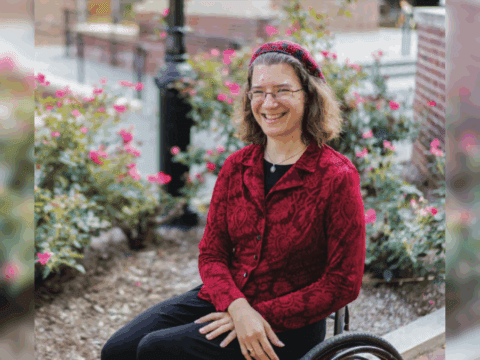Up several flights of creaky wooden stairs, aloft in the bell tower of Montreal’s Saint Patrick’s Basilica, Daniel Désormiers is on a house call.
One of the few church-bell technicians in Canada still plying his trade, Désormiers is trying to locate a glitch in the computerized system that controls the ringing of the bells. Electric current and chip technology has replaced rope-pulling at Saint Patrick’s, a 19th-century architectural gem tucked away in a nondescript patch of the city’s downtown. Standing directly beneath the massive wood-and-iron frame that cradles 10 hefty bronze bells, Désormiers and his young assistant Carl Tremblay run tests on the control panel attached to the greystone masonry of the Gothic revival church. Faulty wiring appears to be the culprit.
“These are bells of a very, very good sound quality,” Désormiers declares after a few dry runs using a temporary bypass system. “They’re bells that were made at a time when people knew how to fine-tune them, when they already had the method to adjust the sound as perfectly as possible.
“As far as we’re concerned, it’s a beautiful set of bells.”
The bells at Saint Patrick’s sound out every hour on the hour between 9 in the morning and 6 in the evening. The pealing of church bells — those “Sacred Noises,” as Canadian composer R. Murray Schafer put it in his book The Soundscape — was once an imposing part of the sonic life of Montreal, dubbed “the city of a hundred bell towers.” This silvery tintinnabulation has over the centuries marked time, called the faithful to mass, celebrated births and marriages, tolled at funerals, warned of fire or flood. But it is fading as church attendance continues to decline, houses of worship silence their bells or simply shut their doors, and the constraints of urban life take hold.
The trend is playing out not only in Quebec, home to about 80 percent of Canada’s estimated 10,000 bronze bells, but in the other provinces, too.
“Church bells’ sound was a sound that we listened for. It had great meaning culturally and socially, and I personally think it’s a little bit sad that we don’t have these aural community markers anymore in ways that we used to,” says Steffen Jowett, a historian whose doctoral thesis explores the sonic history of Montreal between 1965 and 1975. “The more society secularizes, the more these things are just seen as artifacts of the past, and they don’t really signify anything important anymore.”
At the century-old church Saint-Pierre-Claver in Montreal’s Plateau Mont-Royal neighbourhood, the bells have been hushed because of concerns that the vibrations might cause tiles on the bell tower’s roof to fall, says parish priest Rev. Pierre Desroches. At a second congregation he ministers to in the city’s Mile End district, worries over structural problems in the tower have shut down those bells as well.
To help bring in a little extra income, Saint-Pierre-Claver’s twin towers are currently rented out to a cellphone company that uses them as an antenna location.
Churches these days also occasionally find themselves dealing with noise complaints from irate residents living nearby. “Certainly it happens sometimes, especially in residential neighbourhoods that are densely populated. Often it’s because they find that the [bells] ring too long,” says Caroline Tanguay of the Roman Catholic Archdiocese of Montreal. There are only two formal cases she knows of, and in both instances, adjustments were made.
Rev. G. Malcolm Sinclair of Metropolitan United in downtown Toronto says his church is feeling the pressure from frantic condominium development in the rapidly gentrifying area. “I have a feeling that the odder churches become in a secular culture — and we are becoming odder by the year — [the more] there can be pushback. Instead of people saying, ‘We are part of this community, and the church speaks for us,’” soon, he says, the sentiment will be, “‘Who are these people and why are they making these funny noises?’ You know, I can see that coming.”
Metropolitan United boasts the first tuned carillon in North America; it is also the only carillon in The United Church of Canada. An initial 23 bells were donated in 1922 by wealthy Torontonian Chester D. Massey of the famous farm-equipment family. Another 31 bells were donated over subsequent years.
The carillon is “part of the soundscape. My experience is that people crossing through the park in front of the church stop for a moment and listen to the bells,” says Sinclair.
It’s becoming more difficult to highlight the value and significance of bell-ringing in a staunchly secular society — especially in Quebec, says François Mathieu, an artist and author of a 2010 book on the cultural aspects of the province’s church bells. The turn away from organized religion in Quebec since the Quiet Revolution of the 1960s has been particularly forceful.
“The system whereby these ringing sounds are to be validated is very much contested because the religion is itself contested,” he says.
Unfortunately for those still receptive to the sound of chimes ringing out from church spires, efforts to maintain, repair and preserve the existing stock of bells are inadequate. In Quebec, cash-strapped parish churches already face a difficult task in keeping up with more urgent issues like leaky roofs, drafty interiors, broken pipe organs or sagging stained glass windows.
“Church bells are at the end of the list,” says Michael Rowan, a historian and campanologist — a person who studies bells and the art of ringing them — based in Rouyn-Noranda, Que.
The province’s Ministry of Culture and Communications does not have a separate heritage policy for the protection of church bells but can, in certain specific cases, single out a bell for protection if it is deemed to have heritage or cultural value, says spokeperson Karl Filion.
The Québec Religious Heritage Council, a non-profit organization that promotes and helps fund the restoration of heritage-listed religious buildings, was able to provide only $10 million of the $35 million in requests last year for church conservation work generally, says project manager Johanne Picard.
Over the past two decades or so, many Quebec church bells have been sold to more flourishing congregations of various denominations in the United States and elsewhere, says Rowan.
There have also been a few reported cases in the province of inactive bells being stolen to be melted down for their valuable bronze, says Dinu Bumbaru, policy director at Héritage Montreal.
On a more positive note, one Montreal-area Roman Catholic parish managed to breathe new life into an old set of bells. Sainte-Marguerite-Bourgeoys, a church located in a former supermarket in the ethnically diverse suburb of Verdun, recently built a campanile to house four bells purchased from a Roman Catholic church on the south shore of Montreal that was closing.
One bronze ringer not likely to go silent is the “Gros Bourdon” at Notre-Dame Basilica in Old Montreal. Weighing almost 11 tonnes, the massive bell — cast in 1843 by the legendary Whitechapel Bell Foundry in Great Britain — has pride of place in the edifice’s west tower and is safe thanks to the heritage protection afforded the church. Notre-Dame also benefits from its status as a major tourist destination.
But the Gros Bourdon’s manufacturer finds itself in a rather more precarious position. In yet another sign of difficult times for the venerable tradition of sacred noise-making, the owners of Whitechapel Bell Foundry, whose roots can be traced back to the 16th century and the reign of Elizabeth I, announced late last year that the company would be closing, barring an 11th-hour lifeline from an interested buyer.















